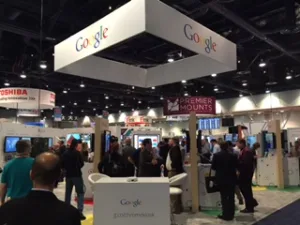One surprise at this year’s show and not at ISE was Google, whose presence could be seen as “the elephant in the room”. The group came with an independent developer booth running a new version of Chrome made for controlling digital signage. In an interview at the show, with Google product manager (in the Chrome Devices Group) Vidya Nagarajan, we got the story behind Chrome Kiosk and Signage software at DSE.
Nagarajan said that they did not sit down at a conference table and suddenly decide to go after the DOOH space. “The way Google got here was quite organic. As you may know, Google has more cafeterias than most small school districts, and we were facing the same problems in control of its digital signage. Our signs were spread out over multiple campuses and for the most part cobbled together in a very inefficient and ineffective way”, she told us.
In 2010, with the release of the Chrome OS pilot program, Google’s internal IT began looking at the cloud approach to target its digital signage problem. The company worked with several vendors (some who were in the Google booth) to create a viable solution. This was also supported by the “Chrome Box for meetings” technology (videoconferencing technology) that was launched in Feb 2014 targeting the business space, and leveraged Chrome OS Management Console. Management Console offers control of up to 10,000 devices via cloud access, with support for multiple groups, user access management, the ability to pre-install and block apps, track access, configure network access and customise user features. In short, many of the key features also needed to control digital signage. The latest organic development from Google that contributed to the firm entering the sign space was Chrome Kiosk mode, allowing the software to run in a single App Kiosk mode and not allowing the user to exit the app.
To Nagaraian, the DOOH market is just the tip of the iceberg in the IoT space, as the company looks to include features including speed; security; simplicity; use of existing HTML5 code; and what Google calls a natural extension to what customers are already doing. So the appearance of Google in this (still) somewhat-niche market had somewhat of a party-crasher feel. Even proprietary software vendor Scala was in the Google booth with an HTML5 based solution the VP of R&D, Steen Laursen told me was created in under one month total.
Analyst Comment
Almost all the vendors I talked to said they saw the company as validating the space, but were a bit concerned about the long-term impact of the search engine giant entering the DOOH market place. But together with Google’s growing list of partners, we think this is a remarkable development in DOOH that indicates its role in helping usher in the Internet of Things. The company is likely to have an impact on some market players in DOOH but ultimately we see the space moving toward an HTML5 standard with simplicity, efficiency and security of a cloud based NOC (network operations center) and full interactivity with an unlimited number of chrome devices (and attached displays) that talk to all things in the mobile world going forward. By the way, today all digital signs in the Google cafeterias are running the Google solution. (SS)
I wrote in October 2013 (Display Monitor Vol 20 Issue 38) about the HTML5 editor, “Google Web Designer” that Google had developed and was available free from the company. Although it wasn’t considered very good for web page design, it was reviewed positively for creating digital signage. The signs that Google would do something in this space have been around for a while! (BR)

